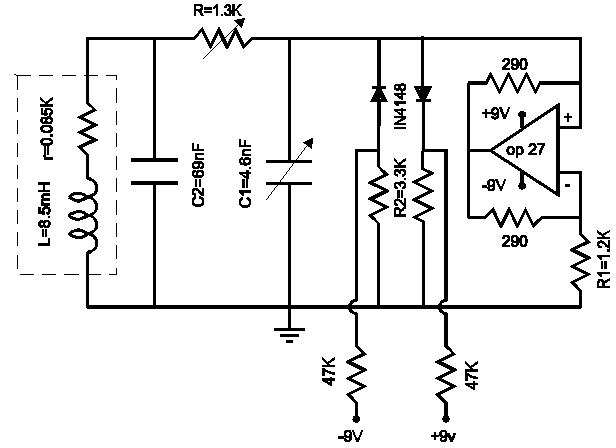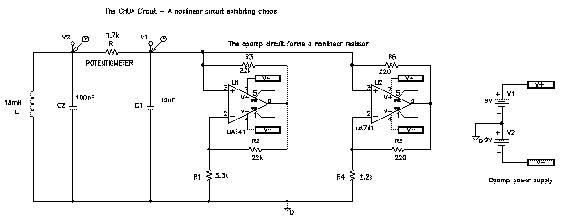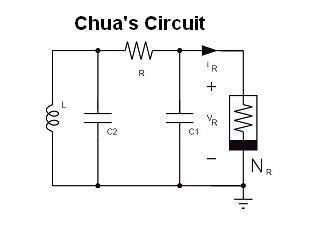 | ||
njit math 491 695 chaos lecture 11 chua s circuit
Chua's circuit (also known as a Chua circuit) is a simple electronic circuit that exhibits classic chaos theory behavior. This means roughly that it is a "nonperiodic oscillator"; it produces an oscillating waveform that, unlike an ordinary electronic oscillator, never "repeats". It was invented in 1983 by Leon O. Chua, who was a visitor at Waseda University in Japan at that time. The ease of construction of the circuit has made it a ubiquitous real-world example of a chaotic system, leading some to declare it "a paradigm for chaos".
Contents
- njit math 491 695 chaos lecture 11 chua s circuit
- Lecture 7 the chua s circuit
- Chaotic criteria
- Models
- References

Lecture 7 the chua s circuit
Chaotic criteria

An autonomous circuit made from standard components (resistors, capacitors, inductors) must satisfy three criteria before it can display chaotic behaviour. It must contain:
- one or more nonlinear elements
- one or more locally active resistors
- three or more energy-storage elements.

Chua's circuit is the simplest electronic circuit meeting these criteria . As shown in the top figure, the energy storage elements are two capacitors (labeled C1 and C2) and an inductor (labeled L; L1 in lower figure). A "locally active resistor" is a device that has negative resistance and is active (it can amplify), providing the power to generate the oscillating current. The locally active resistor and nonlinearity are combined in the device NR which is called "Chua's diode". This device is not sold commercially but is implemented in various ways by active circuits. The circuit diagram below shows one common implementation. The nonlinear resistor is implemented by two linear resistors and two diodes. At the far right is a negative impedance converter made from three linear resistors and an operational amplifier, which implements the locally active resistance (negative resistance).
Models

Analyzing the circuit using Kirchhoff's circuit laws, the dynamics of Chua's circuit can be accurately modeled by means of a system of three nonlinear ordinary differential equations in the variables x(t), y(t) and z(t), which represent the voltages across the capacitors C1 and C2, and the electric current in the inductor L1, respectively. These equations are:

The function f(x) describes the electrical response of the nonlinear resistor, and its shape depends on the particular configuration of its components. The parameters α and β are determined by the particular values of the circuit components.
A computer-assisted proof of chaotic behavior (more precisely of positive topological entropy) in Chua's circuit was published in 1997. A chaotic attractor, known as "The Double Scroll" because of its shape in the (x,y,z) space, was first observed in a circuit containing a nonlinear element such that f(x) was a 3-segment piecewise-linear function.
The easy experimental implementation of the circuit, combined with the existence of a simple and accurate theoretical model, makes Chua's circuit a useful system to study many fundamental and applied issues of chaos theory. Because of this, it has been object of much study, and appears widely referenced in the literature. Further, Chua' s circuit can be easily realized by using a multilayer CNN (Cellular Nonlinear Network). CNNs were invented by Leon Chua in 1988. To date, а large number of various types of chaotic attractors in Chua's system have been discovered,. These may be obtained numerically, with relative ease, by standard computational procedure (after transient process a trajectory, started from a point of unstable manifold in a small neighborhood of unstable zero equilibrium, reaches an attractor and computes it). Also, recently, a hidden Chua's attractor was discovered in the classical Chua circuit, and later smooth and discontinuous variants were identified.
The Chua diode can also be replaced by a memristor; an experimental setup that implemented Chua's chaotic circuit with a memristor was demonstrated by Muthuswamy in 2009; the memristor was actually implemented with active components in this experiment.
